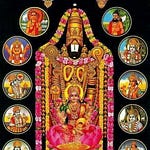Last week, we saw the first two verses of the Śrī Veṅkaṭeśa Suprabhātam.
We noticed that they did not actually refer to Lord Śrīnivāsa Himself! It is with today’s two verses that we get to the first mention of the Lord of Tirupati, although even here we don’t address Him directly: Rather, in a very significant theological choice, the next two verses are actually dedicated to His Supreme Consort, the goddess Padmāvatī Tāyār.
We will also see in these two verses a large number of references, both explicit and implicit, to the famous Catuḥślokī, the four-verse poem overflowing with meaning about the Supreme Goddess Mahālakṣmī that was composed by one of the founders of the Śrīvaiṣṇava tradition, Swāmī Āḷavandār. In order to not interrupt the flow of the text, I will indicate these connections to the Catuḥślokī in the footnotes.
The verses and their translations
Mātaḥ! samasta-jagatāṃ [1] Madhu-Kaiṭabhâ-’rer vakṣo-vihāriṇi! [2] mano(-)hara-divya-mūrte! [3] | Śrī-svāmini! [4] śrita-jana-priya-dāna-śīle! [5] Śrī-Veṅkaṭeśa-dayite! [6] tava suprabhātam || (VSu 3) tava suprabhātam aravinda-locane! [7] bhavatu prasanna-mukha-candra-maṇḍale! [8] | Vidhi-ŚaṅkarÊndra-vanitābhir arcite! [9] Vṛṣa-śaila-nātha-dayite! [10] dayā-nidhe! [11] || (VSu 4)
मातः समस्त-जगतां ! मधु-कैटभा-ऽरेर्वक्षो-विहारिणि ! मनो-हर-दिव्य-मूर्ते ! श्रीस्वामिनि ! श्रित-जन-प्रिय-दान-शीले ! श्री-वेङ्कटेश-दयिते ! तव सुप्रभातम् ॥ 3 ॥ तव सुप्रभातम् अरविन्द-लोचने ! भवतु प्रसन्न-मुख-चन्द्र-मण्डले ! विधि-शंकरे-ऽन्द्र-वनिताभिर् अर्चिते ! वृष-शैल-नाथ-दयिते ! दया-निधे ! ॥ 4 ॥
(3) O Mother to the entire cosmos! You who rejoice upon the broad chest of the Slayer of the demons Madhu and Kaitabha— Your Divine form captivates our minds, Most blessed Mistress of All! You freely and abundantly give to those who surrender unto you all that they desire: O Beloved of Lord Veṅkaṭeśa: a blessed morning to you!(4) A blessed morning to You, o lotus-eyed Lady whose delighted face is like the lunar orb, who are worshipped by the consorts of Brahma, Śiva, and Indra, who are the beloved of Lord Veṅkaṭeśa on Mount Vṛṣa-giri, who are an ocean of compassion!
Notice how the two verses are linked, in what is known as antâdi fashion, by the repeated phrase tava suprabhātam “a blessed morning to you”.1
“What’s in a name?” Everything!
Pace Shakespeare’s Romeo, names are of great importance in the Hindu tradition. A true name, a truly meaningful name captures something of the essence of the person so named. This is particularly true for verses 3 and 4, since from a grammatical perspective they are almost entirely a series of invocations (sambodhanas) to Padmāvatī Tāyār, calling upon Her with no less than eleven different names (numbered above in the verse and translation). As a result we must understand the meanings of these names to appreciate the beauty and the significance of these two verses.
1. Her relation to Her devotees
The very first name given to Her is mātṛ, “mother”. We all know of course the huge significance placed in Indian culture on mothers. But Tāyār is not just a mother, She is Mother to the Entire Cosmos (samasta-jagatām). This is significant in two ways:
She exemplifies the unselfish love and undeserved grace that every mother showers on her child—except She does it to the highest degree and without ever once hesitating or shrinking in the slightest. Hence the capital ‘M’ in calling her “Mother”.
Worldly mothers are partial to their own kids, but She is Mother to the entire cosmos! She is available to each and every one of us in the fullest and highest degree, and does not discriminate among Her children who turn to Her.
In choosing this name as the first invocation, we are invited to contemplate the proper relation between us devotees and Padmāvatī Tāyār.
2. Her relation to Him
The second name, Madhu-Kaiṭabhâ-’rer vakṣo-vihāriṇī, emphasizes the intimacy o of the relation between the Lord and the Lady: They are inseparably bound in union, She resting and rejoicing on His chest even as He destroys demons.
3. The reason for Her relation to Him and us
The next name, manohara-divya-mūrti, then connects the relation between Tāyār and Pĕrumāḷ to the relation between Tāyār and us: it is Her divine form that captivates all minds:
It captivates Pĕrumāḷ’s mind, distracting Him away from the flaws and sins of us devotees (who otherwise deserve to be flogged thoroughly for our transgressions of our respective dharmas!)
It captivates our minds, turning us away from other sources of distraction that lead us away from Her.
4. Her transcendence
But lest we think She is merely a distraction for Pĕrumāḷ in some way, the next name, Śrī-svāminī, tells us Her true position:
She is the Supreme Mistress of everything, equal to Her Divine Consort in every way and thus equally Head of the Cosmos.
By knowing Her to be the co-CEO of the Cosmos, we understand Her essential attribute of paratva—Her transcendence, Her utter “beyond-ness”.
4A. An alternative parsing
The text Śrī-svāmini! can also potentially be read as Śrīḥ! Svāmini!, where the visarga (voiceless breathing) at the end of the first word assimilates into the s of the second word. Under this interpretation, we get two names here. The second name, svāminī, is exactly what we have seen above. But the first name, Śrī, is important too, because it is the Supreme Lady’s personal name, so to speak.2
5. Her immanence
But this is only one half of the puzzle. If we overemphasize this aspect of Her, we will miss out on Her dual attribute, Her sauśīlya—Her extremely easy accessibility, making Herself freely and fully available to all who surrender to Her. This is the aspect emphasized in the next name in the same line (śrita-jana-priya-dāna-śīlā).
6. Her manifestation
And in the last name of the first verse, we are told, just in case we had any doubts, that this marvelous Lady is indeed Padmāvatī Tāyār, the beloved of Lord Veṅkaṭeśa (Śrī-Veṅkaṭeśa-dayitā).
This is the first explicit mention of Lord Veṅkaṭeśa by name in His own Suprabhatam, and it is noteworthy that it comes only after the glory of His Divine Consort is sung.
The word dayitā “beloved” is important here, as it will be repeated in the next verse as well—and is also used in Swāmī Āḷavandār’s Catuḥślokī.
7. Her eyes (and Her solar connection)
Moving now to the second verse addressing Padmāvatī Tāyār, now that we know we are singing specifically about Her temple form (vigraha, arcā), the first name describing Her is aravinda-locanā, describing the beauty of Her eyes. Her side-glances (kaṭākṣa) alone are a blessing unto us, hence the importance of Her beautiful eyes.
Suns and lotuses
The mention of the word aravinda “lotus” is particularly significant for a dawn prayer, for lotuses blossom with daylight. Indeed, the Śrī-Veṅkaṭeśa-Suprabhātam is full of both lotus and solar imagery for this very reason.
The hidden suggestion here is that Tāyār’s celestial-lotus-eyes blossom open because of the radiant celestial Sun that is the Lord: She opens Her eyes to take Him in fully.
8. Her face (and Her lunar connection)
The next name, prasanna-mukha-candra-maṇḍalā, is a beautiful description of the radiant, shining, cool light of Her face: delighted because She is just waking up after resting the whole night with Pĕrumāḷ, but also delighted because She gets to welcome Her children—us—first thing in the morning.3
Ocean, moon, Goddess
Also, the associations between the moon, the ocean, and Tāyār are all important (and we will see connections between Her and both of them in this verse itself): Goddess Mahālakṣmī arises from the Ocean of Milk (kṣīra-sāgara) during the Churning of the Ocean story, and it is also the moon whose tidal forces cause the ocean to rise and churn.
Calling Her own face the moon suggests that this whole incident of Her hiding in the ocean and the ocean having to be churned was all in fact caused by Herself—it was all part of Her own divine free play (līlā).
9. Her relation to the gods
The next name, Vidhi-ŚaṅkarÊndra-vanitābhir arcitā, describes Tāyār’s relation to other divine beings: just as all the gods present themselves at the doorstep of Lord Veṅkaṭeśa every morning and worship Him, so too do all the goddesses worship Her.4
10. Her manifestation repeated
The next name, Vṛṣa-śaila-nātha-dayitā, again reiterates that this is Padmāvatī Tāyār, beloved of Lord Śrīnivāsa who dwells on top of the mountains of Tirupati.5
The repetition of the word dayitā “beloved” underscores the inseparable bond between the Supreme Lord and the Supreme Lady: Their eternal mutual love is, simply put, the fundamental force that binds the entire multiverse together. All the poetry and liturgy and ritual and mythology that re-enacts Their union is a symbolic depiction of this metaphysical force that holds everything together.
11. Her essence
And finally, we have the last name: dayā-nidhi: “ocean of compassion”. If there is one name that can attempt to encapsulate Tāyār for us, it is this one: a boundless, bottomless ocean of pure compassion and love for us.
With this name, we are undoubtedly being reminded of Swāmī Vedānta Deśika’s Dayā-śatakam, in whose 108 verses he sings (for the first time in the Śrīvaiṣṇava tradition) of the compassion (dayā) of Lord Śrīnivāsa of Tirupati personified as the goddess Dayā-devī.
Worldly and spiritual wealth
The word nidhi also means “treasure”, incidentally, and that reference is also important: Many people often pray to the goddess Lakṣmī for material wealth, gold, money, and the like. And of course Tāyār in Her infinite wisdom and compassion blesses Her devotees with worldly prosperity as well.
But the real point of this name is that the real treasure we should be seeking from Her is Her compassion: to be received into Her loving embrace transcends all worldly delight.
Conclusion
The real secret of the matter, the real irony of it, is that we don't even need to seek Her compassion! She is already brimming over with love for us.
All we need to do is turn to Her and call Her “mother!” once, just once, with our hearts full of love and our eyes dimmed with tears of joy, and all this—and more! and infinitely more!—will be ours.
Such is the marvel of Tāyār that even the sages’ Sanskrit Vedas and the saints’ Tamil Prabandhams and the teachers’ beautiful devotional outpourings cannot capture more than a tiny sliver of Her majesty. It is best for an ignorant fool like me to fall silent at this point!
|| Śrī-Padmāvatī-Nāyikā-sameta-Śrī-Veṅkaṭeśa-parabrahmaṇe namaḥ ||
Incidentally, this forces a change in the meter of verse 4: Whereas verse 3 along with verses 5 and beyond are all in the 14-syllable Vasanta-tilakā meter, verse 4 alone is in the 13-syllable Mañju-bhāṣiṇī meter. These are defined (and exemplified) in the Vṛtta-ratnākara of Kedāra Bhaṭṭa as follows:
Sa-Ja-Sā Ja-Gau bhavati Mañju-bhāṣiṇī | (VṛR III.74) uktā Vasanta-tilakā Ta-Bha-Jā Ja-Gau Gaḥ | (VṛR III.79)
As Swāmī Āḷavandār says in his Catuḥślokī:
«Śrīr» ity eva ca nāma te, Bhagavati! (CŚ 1d)
And your name, o Goddess, is “Śrī” itself!
In Verse 3 of his Catuḥślokī, Swāmī Āḷavandār sings the praises of Tāyār’s nectar-like compassionate glances (karuṇā-nirīkṣaṇa-sudhā) and their essential role in bestowing worldly and spiritual blessings upon all beings. He goes so far as to say that without Her favor, there is no way for us to obtain any of our goals. The specific word he uses in v. 3 is Aravinda-locana-manaḥ-kāntā-prasāda “the favor of the Beloved Lady of the mind of the Lotus-eyed Lord”. Notice the two highlighted words here:
Swāmī Āḷavandār uses the name aravinda-locana here to describe the Lord (while in the previous name, we saw it applied, in the feminine, to Tāyār).
The word prasāda “favor / blessing” is derived from the same root as the word prasanna “delighted / pleased / favored” used in this specific name.
This is also a theme in the first verse of the Catuḥślokī as well, where all the gods accompanied by their beloved partners are described as part of Tāyār’s retinue:
BrahmÊśâ-’’di-sura-vrajaḥ sa-dayitas tvad-dāsa-dāsī-gaṇaḥ (CŚ 1c)
The hosts of the gods led by Brahmā and Śiva, accompanied by their spouses, make up Your retinue of attendants.
There is also a gorgeous verse from the Śrī-Stuti of Swami Vedānta Desikar that describes the same situation in slightly greater detail:
ā saṃsāraṃ vitatam akhilaṃ vāṅ-mayaṃ yad-vibhūtir yad-bhrū-bhaṅgāt Kusuma-dhanuṣaḥ kiṃkaro Meru-dhanvā | yasyāṃ nityaṃ nayana-śatakair eka-lakṣyo Mahêndraḥ Padme! tāsāṃ pariṇatir asau bhāva-leśais tvadīyaiḥ || आ संसारं विततम् अखिलं वाङ्मयं यद्-विभूतिर् यद्-भ्रू-भंगात् कुसुम-धनुषः किंकरो मेरु-धन्वा । यस्यां नित्यं नयन-शतकैर् एक-लक्ष्यो महेन्द्रः पद्मे ! तासां परिणतिर् असौ भाव-लेशैस् त्वदीयैः ॥
Sarasvatī—whose form is Speech pervading the whole cosmos; Pārvatī—whose arched eyebrows turned Śiva (who wielded Mount Meru as his bow) into a devotee of Kāmadeva with a flowery bow; Śacī—eternally the sole focus of Indra’s hundreds of eyes— Lotus-lady! All these great goddesses are perfected by tiny slivers of Your being.
And here too we hear echoes of the Catuḥślokī, in whose second verse Mahālakṣmī is invoked as Loka-nātha-dayite “o beloved of the Lord of the Cosmos!”. Of course, there the Lord is described in his Cosmic form, whereas in the Suprabhātam He is described in His temple icon manifestation.









Share this post